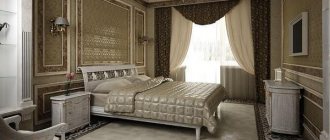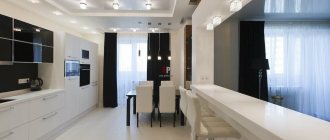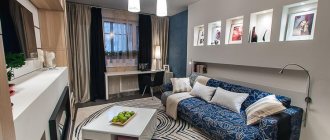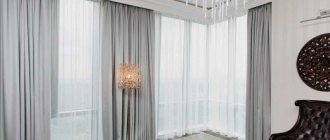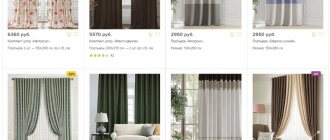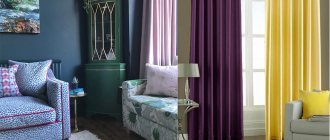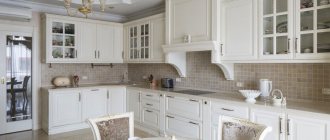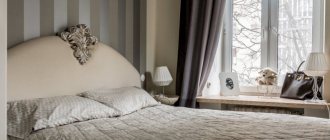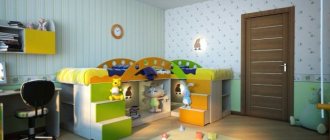The interior decoration of the living room is the character of the room in which we create a comfortable atmosphere. Living room windows are one of the most important components of an elegant interior. The stylish decoration of the windows in the hall is the central link; it will support the entire interior. One of the best window decorations for this room is a lambrequin. So, lambrequins for the hall with photos.
What is a lambrequin
According to the Wikipedia definition, it is “a horizontal decorative drapery located at the top of a curtain composition, window or door opening in the form of a short decorative element across the entire width of the cornice.”
Lambrequins, despite their historical roots (France, 15th – 18th centuries), successfully correspond to modern interior styles and fit organically into modern, high-tech, and country styles. They have many different forms, but are more typical of classics and baroque.
Basic requirements for lambrequins
If you are planning to hang beautiful curtains in a room with a lambrequin or beautiful lambrequins without curtains, then you need to know the main guidelines in order to make the right choice of options. Decorating window openings should create a mood and complement the design of the room, turning the living room into a cozy, elegant space.
Despite the variety of modifications of this decorative element, designers have identified several basic requirements that must be followed in the manufacture and placement of products:
- The lambrequin is placed only at the top of the curtain composition.
- Decorative drapery should be in harmony in fabric and color scheme with the main curtain ensemble (to match the main fabric or its shades, colors of a “related” color palette).
- The length of the textile decor must correspond to the length of the cornice.
- The ratio of the finished height of the lambrequin should be 1/5 or 1/7 of the length of the curtains.
Design of different types of curtains
Lambrequin in window decoration is not always decisive. It is always mounted with curtain or curtain fabric. In modern design, fabrics of different directions are often combined, up to rolled modifications.
Blinds
Compatibility of lambrequins with blinds is preferable for the kitchen, although the option is considered appropriate in the living room. Standard roller blinds give the living room a resemblance to an office space. Thanks to drapery, the interior will become more comfortable and prettier.
Roman
The peculiarity of such curtains is that they are assembled into folds at the top of the window frame. The use of heavy lambrequins is inappropriate. In halls or living rooms, Roman blinds are combined with simple decorative details. An interesting design move is the combination of rich, bright drapery with curtains.
Curtains
Combining a lambrequin with a curtain is the most popular design scheme for window openings in residential premises. The material is a thickened fabric base, contrasting with a light, light curtain.
Traditional elements
Lambrequins include the following traditional elements: swags, crossovers (half-swags), jabot (de jabot), ties, molds, bells and others.
Additional decorative elements are possible: fringe, tassels, braid, cords, flounces, frills, embroidery (including gold threads), edging, figured bottom edge, unusual fastening methods and others.
What forms of drapery are there?
The fabric in curtains can be laid in different ways. Depending on this, there are several options for lambrequin curtains:
- the most common remain svagi, when semicircular elements (2 or 3) are obtained, laid in soft folds (symmetrical or one-sided, plain or contrasting);
- in the form of throws (half-swag), this is when the fabric is thrown over the eaves and has freely hanging edges;
- mold method: the material is folded to form an acute angle (more often used to decorate several adjacent windows on the same wall);
- in the jabot style (de jabot), when on the side there is a wide strip of fabric with beveled edges, somewhat reminiscent of a jabot;
- in the form of a tie, somewhat reminiscent of the previous version, but narrower, when the vertical folds are made as if on top of each other;
- in the form of a cascade made of trapezoid-shaped fabric, falling in rather wide folds, it is made along the entire perimeter, thus emphasizing the boundaries of the opening;
- in the form of a puff (vertical even folds, reminiscent of a pigtail);
- less commonly used bells, when dense fabric is laid in the shape of a cone (it is difficult to achieve such a laying with light fabrics);
- laying in the form of festoons, reminiscent of swags, but wider flounces, more appropriate for large living rooms and high ceilings.
All possible options for photo curtains with a lambrequin give a clear idea of the appearance of all the listed versions.
Possibilities of decorative drapery
With a creative approach and skillful combination of elements, you can create original options for decorative drapery. In addition to the function of decorating the upper edge of the curtains, lambrequins can be used to cover the cornice or imperfections in the fastening of the main curtain panels (if necessary).
A large number of different ways of laying fabric add uniqueness to the living room environment. A large selection of colors, styles, and fabrics allows the products to harmonize with any interior, create a pleasant atmosphere, give windows unique outlines, and receive visual pleasure.
We also recommend: What types of balcony blinds are there and which ones are best to choose?
Festoons and puffs
Fabric laid in a special way, gathered with braided weaving and half rings. From the types of laying the canvas you can get different effects on the overall composition.
A distinction is made between a combined style, when straight fabric is alternated with corrugated and laid sections of fabric.
Types of lambrequins
The main difference between this decorative decoration is the choice of base for production, style and finishing details. The possibilities with these curtain accessories are endless. Wide possibilities for choosing styles, colors and fabrics, lining, length and shape of edge trimming make lambrequins a unique and versatile decorative part of a curtain design.
Lambrequins according to the manufacturing method are conventionally divided into two groups:
- hard;
- soft.
Hard
The rigid lambrequin completely hides the fastening system and the cornice itself. Choose any shape that suits your windows - with smooth, rounded or curly edges. A rigid lambrequin can be additionally equipped with decorative elements. Edging, braid, tassels - all this adds aesthetics to the design of lambrequins.
Bando
This lambrequin is a rigid base on which fabric is stretched without folds. The bandeau usually covers the cornice, has a flat or shaped bottom edge, and can have different configurations. Usually covered with the same fabric as the curtains (for example, thick jacquard fabrics) or felt.
A rigid lambrequin is simple in outline and, with its intelligent restraint, can decorate not only the hall, but also other rooms.
Bando can also be made on a soft base, without the use of plywood or plastic. In this case, the outer layer of the main fabric is attached to the lower soft base, which is made either from felt or from very dense fabric, folded in 2-3 layers, giving it the desired shape in advance.
Soft
Soft types of lambrequins are made from both light and dense fabrics. Fabrics that drape easily and form soft folds are best.
Complex fabric structures can be assembled from different elements and can be decorated with decorative elements:
- fringe;
- brushes;
- cords;
- others.
Materials for production
It is important to choose the right fabric. As a rule, curtains and lambrequins are made of the same materials. However, for their manufacture, you can choose any fabric, selecting color shades and patterns that match the style of your room:
- tulle fabrics (veil, chiffon and others);
- thin curtain fabrics (silk, linen and others);
- dense curtain fabrics (satin, jacquard, velor, velvet and others).
Before designing a window opening, decide on the basic concept of the interior design, then choose the fabric. At the same time, it is appropriate to remember that dense materials of dark colors visually reduce the space, and with the help of light and light fabrics you can visually expand it.
Drapery forms
Soft lambrequins differ in the methods of assembly and arrangement of folds (drapery forms):
- svagi - the most common form, which consists of folds of fabric elegantly hanging in the form of semi-arches from the top of the curtains;
- semi-swagi (throwovers) - a strip of fabric, folded, is thrown over the curtain rod, one end is attached to the cornice or the top of the curtain, the other end hangs freely;
- molds - vertical sharp-angled folds with folds placed inside or outside the product; is located, as a rule, in the center of the lambrequin;
- Jabot (de Jabot) is an asymmetrical element framing the edges of the curtains. The draping of the fabric in folds with corners resembles a frill: the shortened side usually “looks” into the middle of the window space, the long side is directed outward;
- tie - a decorative item folded into folds with the short side directed outward. Reminiscent of a jabot, but narrow and much smaller in size;
- bell (bell) - a piece of fabric folded in the shape of a cone, made exclusively from dense materials to maintain its shape;
- simple assembly - a strip of fabric is 1.5-2 times longer than the cornice. The entire strip of fabric (frill) is gathered (pulled together) on the cornice. It can be attached separately to the cornice using a drawstring through which a round cornice is threaded, or attached to rings, or attached to the top of the curtain panel. The assembly is distributed along the entire length of the cornice.
Combined
Combined lambrequins are a symbiosis of different models of lambrequins: for example, a rigid bandeau with openwork decor, or with soft fabric folds repeated in different sequences, or other options.
Combined lambrequins are the most pompous and solemn. Such lambrequins look great in spacious living rooms with high ceilings.
We also recommend: Tulle in the living room: decorating windows in modern styles
However, exercise restraint in your desire to decorate the curtains, avoiding going overboard with the number and appearance of details.
Tulle with lambrequin: the use of such systems and their advantages
Tulle is a single piece of fabric that is hung directly under the surface of the curtains. As a rule, some transparent and lightweight material is used to make it, designed to only slightly dim the light and slightly tint the color of the main canvases. The most popular and widespread material is organza, since it has all the necessary properties and has a suitable fabric structure. In its classic design, the tulle curtain is a solid and monolithic fabric that covers not only the entire window opening, but also part of the wall near it.
Design options for curtains with lambrequins for the hall - photo
Lambrequins for the hall - new items
Lambrequin is a detail of the classic window design style. Its manufacture and fastening are not simple in all cases. But it can become an object of fashionable design, a masterpiece of fine workmanship, a unique decorative addition to a curtain ensemble.
Along with the classic options, thanks to the creative searches of designers and the ideas of the users themselves, new models of lambrequins, technologies for their production, and methods of fastening appear.
Openwork hard
In the last few years, openwork varieties of rigid lambrequins have been gaining popularity. They complement any interior styles - from classic to modern. Openwork lambrequins are considered a novelty. They can be used either together with curtains or separately, without curtains.
They are a rigid carved product made of hard materials (bando or plastic). Manufactured using laser cutting. An openwork lambrequin can also be made in the form of a decorative strip (ribbon) or a modular design (combines several individual figured ornaments).
By the way, we have an excellent article on how to make openwork lambrequins with your own hands.
Openwork made of cord
An openwork lambrequin made of cord is another novelty among lambrequins. The basis is a cord equipped with a thin metal wire running inside the cord. From this base, an openwork pattern is made according to the prepared pattern.
Buffs
One of the modern forms of drapery - puffs - is also a new product that has appeared recently. This detail of window decoration is made from a piece of fabric with a special hand-assembly using separate stitches according to a pattern, resulting in puffs of different shapes (braid, braid, etc.). A lambrequin made in the form of a puff can serve as an unusual decorative addition to curtains and can be used independently - without curtains.
Model Update
Traditional lambrequin models can be updated in various ways:
- decoration using exquisite patterns made with twisted or braided cords and braid;
- selection of a unique shape of lambrequin parts;
- adding openwork elements;
- a combination of different types and elements of lambrequins;
- unique hanging methods.
Color selection
When creating a holistic composition for any room, it is necessary to take into account the color scheme of other interior details: wallpaper, furniture, textiles.
The window design can be selected in contrast to the rest of the decoration or by adhering to the main tone of the room. With the first option, the windows will be a kind of accent of the room, and with the second option, an “enveloping” effect is created.
For small windows, it is important that the color of the curtain fabric does not absorb daylight. Light tones of curtains of any shade - warm and cold - fill the room with air and light. The lambrequin should naturally frame and complement such a design.
Bright, rich colors look good in the kitchen. A design designed in such colors can become the main decorative element of the kitchen. Using lemon, orange, and light green shades you can add cheerful notes to any interior. It would also be appropriate to use various applications that will add uniqueness.
With imagination and minimal knowledge, you can achieve uniqueness and charm for a room with any initial data.
Nowadays, curtains are not only an interior item that protects the room from the penetration of sunlight and prying eyes, but also a decorative detail that makes it possible to emphasize the stylistic direction of the decor or focus attention on the window opening.
Modern apartments do not always please us with large rooms. Cramped rooms with low ceilings largely limit the design solutions of curtains. But even for small window openings it is possible to choose original curtains that allow you to visually increase their area and, at the same time, fulfill their direct responsibilities.
Lambrequins for a hall without curtains
Lambrequins can be used to decorate windows as an independent component - without curtains, depending on the shape of the window, the style of the interior and your preferences. However, most often, lambrequins without curtains are used to decorate kitchen windows (due to the small size of the room and/or small-format windows). But lambrequins without curtains will be quite appropriate in the hall if:
- the size of the hall is small;
- there are small windows in the hall;
- from the living room there is access to the balcony;
- your living room design has an oriental style.
It is necessary to clarify what is meant by the words “no curtains”. If we are talking about the living room, then it would be more accurate to say - without curtains, but only in combination with light tulle curtains. A bare window does not look aesthetically pleasing. In addition, it is necessary to provide at least light shading, comfort in the room and protection from the street.
We also recommend: Fashionable curtains for the kitchen in 2021
When experimenting with models of lambrequins and curtains, remember that your ideas must match the style of the living room interior, and the textile decorations of the windows must fulfill their traditional functions necessary to ensure comfort in the room.
Lambrequins for various rooms
Curtains with lambrequins are suitable for any room. Design, fabric, colors depend on the purpose of the room, window size, and interior.
Curtains with lambrequins in the living room
When choosing a lambrequin for the living room, you should focus on the style of the room. The hard version will give the room solidity, the soft one will create a romantic atmosphere, the combined one will emphasize sophistication and at the same time remove stiffness. The fashionable openwork lambrequin is of the rigid type.
Related article: Technology and video: how to glue liquid wallpaper on a wall
Curtains with a lambrequin for the living room, made in the classical, baroque, empire style, are usually sewn luxuriously and are a complete decoration of the room. Decorations made from swags, de jabots, chill molds, and lush draperies, the sound of which is muffled by switchbacks, would be appropriate here. Curly, symmetrical, straight, asymmetrical shapes are used equally. When combining swags and flips, the latter are made from transparent fabrics.
Living room model
If curtains with a lambrequin are selected for a hall in the Art Nouveau style, then preference is given to multi-layer structures made of transparent and translucent fabrics. It would be appropriate to use floral prints, pastel colors, soft lines and outlines. Country, hi-tech and techno presuppose the presence of simple forms.
In the bedroom
To create the right ambience in the bedroom, draped decorations made of translucent fabrics are usually used. In a small room, the curtain and lambrequin have a small number of folds. The window decor is done in pastel colors without sharp contrasts.
Using a rigid structure in the bedroom is acceptable, but it makes the interior heavier and makes the ceiling visually lower.
Curtains with lambrequins for the kitchen
In a small-sized kitchen, it is better to do without the decorative design of the top of the curtains or use it separately. Air crossover or swag with de jabot goes well with roller or horizontal blinds. If you really want to hang a curtain with a lambrequin, its color should match the curtains and not be contrasting.
In a large kitchen, where the dining area is separate from the working area, the use of any decor is acceptable. Usually a combination with the dining room setting is chosen.
Lambrequins for a hall with two windows
The placement of curtains with lambrequins or separate lambrequins for a hall with two windows can be symmetrical or asymmetrical. Lambrequins can be hung on each window separately or by combining both windows into a single composition. In this case, consider the advisability of using a three-row cornice.
Your choice will depend on how the windows are positioned relative to each other and adjacent walls, the furnishings of the room and your preferences.
When choosing a lambrequin model, you need to be based on the overall design of the living room and the relative position of the windows, if there is more than one.
Beautiful lambrequins for the hall - photo
We offer a selection of photos with samples of lambrequins for the hall: classic and modern models (including new items), for your inspiration when creating an exquisite design for the windows of your living rooms.
